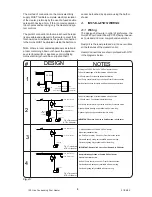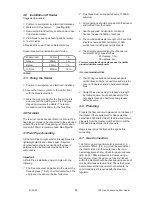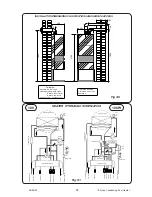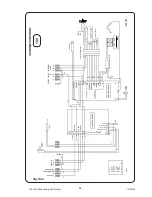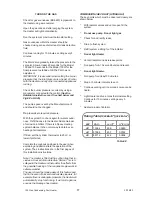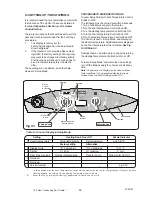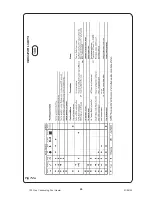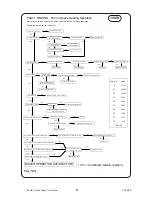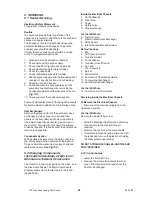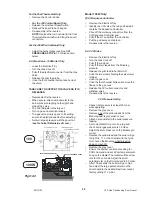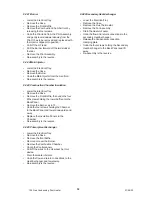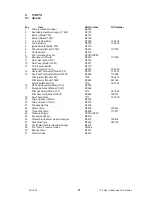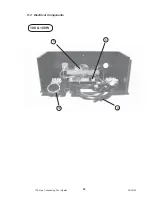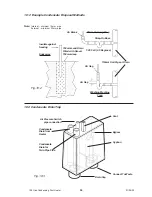
7.2 Ignition Faults
Model 100 Only
WARNING: BEFORE COMMENCING OR COM-
PLETING ANY ELECTRICAL WORK ON THE
APPLIANCE, IT IS RECOMMENDED THAT THE
BASIC SAFETY CHECKS FOR EARTH CONTINU-
ITY, SHORT CIRCUIT, POLARITY AND RESIST-
ANCE TO EARTH ARE MADE. ALL WORK
CARRIED OUT SHOULD FOLLOW GUIDELINES
LAID DOWN BY THE I.E.E.
The Ignition sequence in the Heater is straight
forward and faults can easily be traced if these
simple steps are followed.
Demand to Heat
Pool Thermostat closed
Boiler Thermostat closed
Ignition Control energised
Flue Stat closed
Overheat Stat closed
Trap not blocked
Pressure Switch open
Fan energised.
Pilot Ignition
Main Burner Ignition
If there is a request to heat the Pool, or if con-
nected, the Space Heating, a mains signal will
appear at the POOL DEMAND or HTG DEMAND
connector in the Heater.
For Pool Heating
If the Pool Thermostat Board finds the Pool is
below the set temperature it will put mains on the
BURNER connection of the Pool Thermostat
Board.This is indicated by the LED on the Pool
Thermostat Board. This is connected to the Ignition
Board at its Ls, (Switched Live) connection and the
boiler will then start its ignition process.
For Space Heating (if connected)
If the Pool Thermostat Board finds the Pool is up to
temperature or it has been set for Heating Priority,
it will put mains on the BURNER and HTR PUMP
connections. This is indicated by the LEDs on the
Pool Thermostat Board. The BURNER signal is
connected to the Ignition Board at its Ls, (Swiched
Live) connection and the boiler will then start its
ignition process. The HTR PUMP signal is used to
move the 3 way valve to Heating.
Ignition
Both the 100 and the100W follow the same se-
quence however there are indicators on the 100 to
show these steps. The description below uses the
100 to describe the process.
Lamps on the edge of the Ignition Board indicate
the stages in the ignition sequence. Please refer to
the lable inside the Heater.
Permanent live has to be connected to the L
terminal then the Power lamp lights.
A call for heat powers the Ls terminal and the
Running and Pump lamps light.
Provided the Flue Stat, Overheat Stat and Heater
are cold, the fan starts up. The pressure switch
detects the correct airflow and that the condensate
drain is not blocked then, switches over. This is
indicated by the Fan lamp illuminating.
The Pilot lamp illuminates, the pilot gas valve
opens and the Ignition Control Board provides a
spark at the pilot electrode.
(If the L and N supply are
reversed the Heater will not progress beyond pilot
ignition. This is indicated by the Phase Reversed neon
behind the knob lighting.)
The pilot flame is detected and the Ignition Control
Board stops sparking and then energises the main
gas valve and the Burner lamp is illuminated.
The pilot flame lights the burner, and it stays alight
until turned off by the control thermostat, system
controls, or in the case of a fault condition a safety
thermostat.
The flue thermostat will trip if the flue exceeds a
pre-set temperature. The overheat thermostat will
trip if the water flow rate is insufficient, both are
indicated by the Lockout lamp illuminating.
NOTE: The Heater has a built-in delay timer. It is
indicated by the Running lamp flashing.
For testing, switching the Mains Supply off for a few
seconds, then back on again will reset the delay.
Fault Diagnosis
The fault Diagnosis chart shows the normal and
fault sequences for the Ignition Board indicator
lamps.
To diagnose a fault, use the following procedure.
•
Turn off the system Mains supply.
•
Set all thermostats and timers to a call for
heat position.
•
Turn on the system Mains supply and watch
the Ignition Board indicator lamps.
Compare the lamps with the diagnosis chart oppo-
site to determine the fault and cause.
23
100 Gas Condensing Pool Heater
20/10/03

